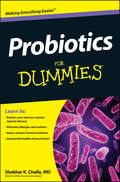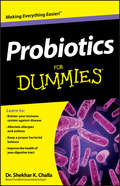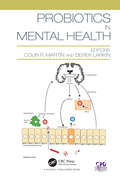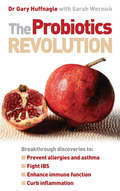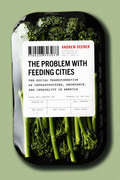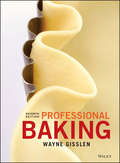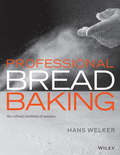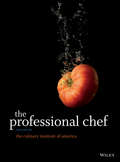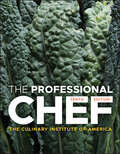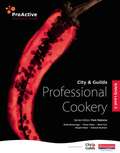- Table View
- List View
Probiotics and Prebiotics in Food, Nutrition and Health
by Semih OtlesPresenting the work of international experts who discuss all aspects of probiotics and prebiotics, this volume reviews current scientific understanding and research being conducted in this area. The book examines the sources and production of probiotics and prebiotics. It explores their use in gastrointestinal disorders, infections, cancer preventi
Probiotics For Dummies
by Shekhar ChallaDiscover the pros of probiotics Probiotics are beneficial, live microorganisms (in most cases, bacteria) that are similar to those found naturally in the human intestine. Also known as "friendly" or "good" bacteria, probiotics are the cornerstone of any successful health program because they restore a healthy balance between friendly and bad bacteria in the intestinal tract, a balance that is critical for the health of the entire body. Probiotics are associated with treating everything from IBS to certain forms of cancer, allergies, eczema, and even the effects of aging. Probiotics For Dummies reveals how taking the right probiotics—in the form of food and supplements— as part of a total health program benefits one's overall health, as well as improving specific conditions. This hands-on, essential guide features 20 probiotic recipes and gives you a step-by-step plan for infusing probiotics into your diet to improve the health of the GI tract, alleviate allergies and asthma, restore reproductive and urinary tracts, bolster the immune system against disease, enhance weight loss, and more. Advice on how to ingest the right probiotics 20 probiotic recipes from breakfast to dessert Information on naturally occurring probiotic compounds as well as the effectiveness of supplements Probiotics For Dummies gives you everything you need to make informed decisions about adding probiotics to your daily diet.
Probiotics For Dummies
by Shekhar ChallaDiscover the pros of probiotics Probiotics are beneficial, live microorganisms (in most cases, bacteria) that are similar to those found naturally in the human intestine. Also known as "friendly" or "good" bacteria, probiotics are the cornerstone of any successful health program because they restore a healthy balance between friendly and bad bacteria in the intestinal tract, a balance that is critical for the health of the entire body. Probiotics are associated with treating everything from IBS to certain forms of cancer, allergies, eczema, and even the effects of aging. Probiotics For Dummies reveals how taking the right probiotics—in the form of food and supplements— as part of a total health program benefits one's overall health, as well as improving specific conditions. This hands-on, essential guide features 20 probiotic recipes and gives you a step-by-step plan for infusing probiotics into your diet to improve the health of the GI tract, alleviate allergies and asthma, restore reproductive and urinary tracts, bolster the immune system against disease, enhance weight loss, and more. Advice on how to ingest the right probiotics 20 probiotic recipes from breakfast to dessert Information on naturally occurring probiotic compounds as well as the effectiveness of supplements Probiotics For Dummies gives you everything you need to make informed decisions about adding probiotics to your daily diet.
Probiotics in Mental Health
by Colin R. Martin Derek LarkinThe concept that the gut and brain are intricately linked is widely accepted not just within the lay community but increasingly within scientific and therapeutic circles as well. Terms such as "heartache" and "gut wrenching" are more than mere metaphor, they represent key fundamental aspects of human experience which all individuals will invariably endure from time to time. The relationship between the gut and brain is complex but fundamental to health and wellbeing. Increasing and compelling evidence supports the existence of a relationship between the health and status of the gut and the manifestation of significant psychopathology. Uniquely within the field of mental health and psychiatry, the role of gut flora and probiotics in both the understanding and treatment of mental illness represents an emerging science whether the potential for therapeutic intervention, through the use of probiotics, offers an opportunity to determine efficacy within a coherent evidence-based model of both action and pathology or, moreover, offers interventions that are comparatively benign compared to the side-effect profile associated with most drugs used to treat mental illness. Probiotics in Mental Health examines the role of probiotics in a range of clinical presentations associated with significant psychopathology and facilitates a reconsideration of how mental illness may be conceptualised within a coherent gut-brain model of health and wellbeing. Under the rubric of enhancing wellbeing rather than dwelling on illness and disease, this exciting new volume not only comprises the latest evidence in the field but also advocates an approach characterised by the understanding of mental disorder within an evidence-based model and the pursuit of mental health and wellbeing through the most benign of interventions.
Probiotics in Mental Health
by Martin Colin R Derek LarkinThe concept that the gut and brain are intricately linked is widely accepted not just within the lay community but increasingly within scientific and therapeutic circles as well. Terms such as "heartache" and "gut wrenching" are more than mere metaphor, they represent key fundamental aspects of human experience which all individuals will invariably endure from time to time. The relationship between the gut and brain is complex but fundamental to health and wellbeing. Increasing and compelling evidence supports the existence of a relationship between the health and status of the gut and the manifestation of significant psychopathology. Uniquely within the field of mental health and psychiatry, the role of gut flora and probiotics in both the understanding and treatment of mental illness represents an emerging science whether the potential for therapeutic intervention, through the use of probiotics, offers an opportunity to determine efficacy within a coherent evidence-based model of both action and pathology or, moreover, offers interventions that are comparatively benign compared to the side-effect profile associated with most drugs used to treat mental illness. Probiotics in Mental Health examines the role of probiotics in a range of clinical presentations associated with significant psychopathology and facilitates a reconsideration of how mental illness may be conceptualised within a coherent gut-brain model of health and wellbeing. Under the rubric of enhancing wellbeing rather than dwelling on illness and disease, this exciting new volume not only comprises the latest evidence in the field but also advocates an approach characterised by the understanding of mental disorder within an evidence-based model and the pursuit of mental health and wellbeing through the most benign of interventions.
Probiotics in Pediatric Medicine (Nutrition and Health)
by Sonia Michail Philip M. ShermanProbiotics in Pediatric Medicine provides clinicians a tool to understand the current evidence for the role of probiotics in various pediatric disorders related to the gastrointestinal as well as the extra-intestinal tract. This book provides evidence-based up-to-date information from world experts in their fields to help clinicians make decisions regarding the use of probiotics. A list of resources, web sites, and references relevant to probiotics can be found in the appendix. Currently, the market for probiotics continues to rely heavily on health claims made by manufacturers and retailers. Clinicians have the sole responsibility to understand the various strains and preparations commercially available and to advise patients accordingly. Probiotics in Pediatric Medicine is an indispensable tool and a critical resource for health professionals that will aid in enhancing their ability to make the appropriate decisions regarding the use of probiotics.
The Probiotics Revolution: The Definitive Guide To Safe, Natural Health Solutions Using Probiotic And Prebiotic Foods And Supplements
by Dr Gary Huffnagle Sarah WernickIf the thought of bacteria conjures up images of germs that should be avoided at all costs - and certainly not ingested - think again! Some friendly bacteria, called probiotics, are not only beneficial to your health, they're essential. Now one of the leading researchers in the field sheds light on the extraordinary benefits of these natural health superstars. The Probiotics Revolution is an up-to-the-minute, highly accessible guide to probiotics and the foods and supplements that contain and support them. Discover:- The key role of probiotics and prebiotics in restoring healthy balance to our bodies- How to use probiotic foods and supplements to prevent and relieve allergies, IBS, yeast infections and much more- A step-by-step plan for incorporating probiotics and prebiotics into your diet- A complete buyer's guide to probiotic supplements- How to introduce probiotics to your family and childrenWith new evidence to suggest that probiotics may help to fight asthma, cardiovascular disease, breast and colon cancer, autoimmune disease, chronic fatigue and even obesity, this is more than just Yakult - it is the health guide for 2007.
Probiotics, the Natural Microbiota in Living Organisms: Fundamentals and Applications (Industrial Biotechnology)
by Hesham Ali El-Enshasy Shang-Tian YangBeneficial microbes called probiotics exist naturally in our bodies and play a vital role in our health. Probiotics have been known to produce important microbiota of antimicrobial compounds that enhance our immunity to counter the harmful effects of pathogenic organisms. These microbes are also used in the treatment of diseases and in negating the side effects of chemically synthesized medicines. The study of probiotic organisms and their wide applications in industrial products for human and animal uses has thus gained momentum. This book provides a comprehensive review on the research and applications of probiotics. It serves as a reference and resource for undergraduate and postgraduate students, researchers, companies, and policy makers who are active in fields related to functional food and feed, industrial biotechnology, nutraceuticals, and medicine. All chapters in this book have been written and edited by leading experts in the respective fields from academia, industry, or government.
Probiotics, the Natural Microbiota in Living Organisms: Fundamentals and Applications (Industrial Biotechnology)
by Hesham Ali El-Enshasy Shang-Tian YangBeneficial microbes called probiotics exist naturally in our bodies and play a vital role in our health. Probiotics have been known to produce important microbiota of antimicrobial compounds that enhance our immunity to counter the harmful effects of pathogenic organisms. These microbes are also used in the treatment of diseases and in negating the side effects of chemically synthesized medicines. The study of probiotic organisms and their wide applications in industrial products for human and animal uses has thus gained momentum. This book provides a comprehensive review on the research and applications of probiotics. It serves as a reference and resource for undergraduate and postgraduate students, researchers, companies, and policy makers who are active in fields related to functional food and feed, industrial biotechnology, nutraceuticals, and medicine. All chapters in this book have been written and edited by leading experts in the respective fields from academia, industry, or government.
The Problem with Feeding Cities: The Social Transformation of Infrastructure, Abundance, and Inequality in America
by Andrew DeenerFor most people, grocery shopping is a mundane activity. Few stop to think about the massive, global infrastructure that makes it possible to buy Chilean grapes in a Philadelphia supermarket in the middle of winter. Yet every piece of food represents an interlocking system of agriculture, manufacturing, shipping, logistics, retailing, and nonprofits that controls what we eat—or don’t. The Problem with Feeding Cities is a sociological and historical examination of how this remarkable network of abundance and convenience came into being over the last century. It looks at how the US food system transformed from feeding communities to feeding the entire nation, and it reveals how a process that was once about fulfilling basic needs became focused on satisfying profit margins. It is also a story of how this system fails to feed people, especially in the creation of food deserts. Andrew Deener shows that problems with food access are the result of infrastructural failings stemming from how markets and cities were developed, how distribution systems were built, and how organizations coordinate the quality and movement of food. He profiles hundreds of people connected through the food chain, from farmers, wholesalers, and supermarket executives, to global shippers, logistics experts, and cold-storage operators, to food bank employees and public health advocates. It is a book that will change the way we see our grocery store trips and will encourage us all to rethink the way we eat in this country.
The Problem with Feeding Cities: The Social Transformation of Infrastructure, Abundance, and Inequality in America
by Andrew DeenerFor most people, grocery shopping is a mundane activity. Few stop to think about the massive, global infrastructure that makes it possible to buy Chilean grapes in a Philadelphia supermarket in the middle of winter. Yet every piece of food represents an interlocking system of agriculture, manufacturing, shipping, logistics, retailing, and nonprofits that controls what we eat—or don’t. The Problem with Feeding Cities is a sociological and historical examination of how this remarkable network of abundance and convenience came into being over the last century. It looks at how the US food system transformed from feeding communities to feeding the entire nation, and it reveals how a process that was once about fulfilling basic needs became focused on satisfying profit margins. It is also a story of how this system fails to feed people, especially in the creation of food deserts. Andrew Deener shows that problems with food access are the result of infrastructural failings stemming from how markets and cities were developed, how distribution systems were built, and how organizations coordinate the quality and movement of food. He profiles hundreds of people connected through the food chain, from farmers, wholesalers, and supermarket executives, to global shippers, logistics experts, and cold-storage operators, to food bank employees and public health advocates. It is a book that will change the way we see our grocery store trips and will encourage us all to rethink the way we eat in this country.
The Problem with Feeding Cities: The Social Transformation of Infrastructure, Abundance, and Inequality in America
by Andrew DeenerFor most people, grocery shopping is a mundane activity. Few stop to think about the massive, global infrastructure that makes it possible to buy Chilean grapes in a Philadelphia supermarket in the middle of winter. Yet every piece of food represents an interlocking system of agriculture, manufacturing, shipping, logistics, retailing, and nonprofits that controls what we eat—or don’t. The Problem with Feeding Cities is a sociological and historical examination of how this remarkable network of abundance and convenience came into being over the last century. It looks at how the US food system transformed from feeding communities to feeding the entire nation, and it reveals how a process that was once about fulfilling basic needs became focused on satisfying profit margins. It is also a story of how this system fails to feed people, especially in the creation of food deserts. Andrew Deener shows that problems with food access are the result of infrastructural failings stemming from how markets and cities were developed, how distribution systems were built, and how organizations coordinate the quality and movement of food. He profiles hundreds of people connected through the food chain, from farmers, wholesalers, and supermarket executives, to global shippers, logistics experts, and cold-storage operators, to food bank employees and public health advocates. It is a book that will change the way we see our grocery store trips and will encourage us all to rethink the way we eat in this country.
The Problem with Feeding Cities: The Social Transformation of Infrastructure, Abundance, and Inequality in America
by Andrew DeenerFor most people, grocery shopping is a mundane activity. Few stop to think about the massive, global infrastructure that makes it possible to buy Chilean grapes in a Philadelphia supermarket in the middle of winter. Yet every piece of food represents an interlocking system of agriculture, manufacturing, shipping, logistics, retailing, and nonprofits that controls what we eat—or don’t. The Problem with Feeding Cities is a sociological and historical examination of how this remarkable network of abundance and convenience came into being over the last century. It looks at how the US food system transformed from feeding communities to feeding the entire nation, and it reveals how a process that was once about fulfilling basic needs became focused on satisfying profit margins. It is also a story of how this system fails to feed people, especially in the creation of food deserts. Andrew Deener shows that problems with food access are the result of infrastructural failings stemming from how markets and cities were developed, how distribution systems were built, and how organizations coordinate the quality and movement of food. He profiles hundreds of people connected through the food chain, from farmers, wholesalers, and supermarket executives, to global shippers, logistics experts, and cold-storage operators, to food bank employees and public health advocates. It is a book that will change the way we see our grocery store trips and will encourage us all to rethink the way we eat in this country.
Proceedings of ICEPP 2021: Efficient Production and Processing (Lecture Notes in Civil Engineering #190)
by Yury VankovThis book gathers the latest advances, innovations, and applications in the field of environmental and construction engineering, as presented by international researchers and engineers at the 2nd International Conference on Efficient Production and Processing, held on February 25-26, 2021. It covers highly diverse topics, including use of secondary raw materials in construction technologies; urban waste management logistics; use of recycled materials in road construction; safety and security in waste handling; food science and agriculture; waste and water treatment; and environmental economics. The contributions, which were selected by means of a rigorous international peer-review process, highlight numerous exciting ideas that will spur novel research directions and foster multidisciplinary collaborations.
Processed Food Addiction: Foundations, Assessment, and Recovery
by Joan Ifland Marianne T. Marcus Harry G. PreussObesity and eating disorders have stubbornly refused to respond to treatment since the 1990’s. This book organizes the evidence for a possible answer, i.e., that the problem could be one of addiction to processed foods. In a Processed Food Addiction (PFA) model, concepts of abstinence, cue-avoidance, acceptance of lapses, and consequences all play a role in long-term recovery. Application of these concepts could provide new tools to health professionals and significantly improve outcomes. This book describes PFA recovery concepts in detail. The material bridges the research into practical steps that health professionals can employ in their practices. It contains an evidence-based chapter on concepts of abstinence from processed foods. It rigorously describes PFA pathology according to the DSM 5 Addiction Diagnostic Criteria. It applies the Addiction Severity Index to PFA so that health practitioners can orient themselves to diagnosing and assessing PFA. It contains ground-breaking insight into how to approach PFA in children. Because the book is evidence-based, practitioners can gain the confidence to put the controversy about food addiction to rest. Practitioners can begin to identify and effectively help their clients who are addicted to processed foods. This is a breakthrough volume in a field that could benefit from new approaches.
Processed Food Addiction: Foundations, Assessment, and Recovery
by Joan Ifland Marianne T. Marcus Harry G. PreussObesity and eating disorders have stubbornly refused to respond to treatment since the 1990’s. This book organizes the evidence for a possible answer, i.e., that the problem could be one of addiction to processed foods. In a Processed Food Addiction (PFA) model, concepts of abstinence, cue-avoidance, acceptance of lapses, and consequences all play a role in long-term recovery. Application of these concepts could provide new tools to health professionals and significantly improve outcomes. This book describes PFA recovery concepts in detail. The material bridges the research into practical steps that health professionals can employ in their practices. It contains an evidence-based chapter on concepts of abstinence from processed foods. It rigorously describes PFA pathology according to the DSM 5 Addiction Diagnostic Criteria. It applies the Addiction Severity Index to PFA so that health practitioners can orient themselves to diagnosing and assessing PFA. It contains ground-breaking insight into how to approach PFA in children. Because the book is evidence-based, practitioners can gain the confidence to put the controversy about food addiction to rest. Practitioners can begin to identify and effectively help their clients who are addicted to processed foods. This is a breakthrough volume in a field that could benefit from new approaches.
Production Diseases in Farm Animals: Pathophysiology, Prophylaxis and Health Management
by Josef Johann GrossThis textbook deals comprehensively with livestock production diseases and their prevention in the major species: ruminants, swine, and poultry. It gives an interdisciplinary view on pathophysiology, prophylaxis, and health management.Livestock breeding and husbandry is often accompanied by a conflict of interest between the animal´s biological requirements and economic producer needs. This conflict is increasingly gaining attention not only by producers, animal scientists, and veterinarians, but also by the public. It creates significant future challenges, which are described and addressed in this book. The main topics covered are: • the use of antimicrobials with emphasis on security and safety for producers/consumers• the impact of locomotion disorders on performance and welfare of farm animals • the interactions of gut microbiome, genetics, climate change, metabolic status and mineral homeostasis with reproduction, performance, animal health and welfare• infectious and respiratory diseases• the raising of neonatesA special section is devoted to behavioural signs indicating an impaired animal welfare. These are the basis for precision livestock farming (PLF) technology and the development of new management concepts. The present work is a valuable resource for veterinarians, students, as well as expert readers from animal and agricultural sciences, food safety and technology. Supplementary videos can be accessed online as well as directly from the print book; simply download the Springer Nature More Media App for free and scan the links with the play button.
Professional Baking
by Wayne GisslenProfessional Baking, 7th Edition is the latest release of the market leading title for the baking course. Focused on both understanding and performing, its goal is to provide students and working chefs with a solid theoretical and practical foundation in baking practices, including selection of ingredients, proper mixing and baking techniques, careful makeup and assembly, and skilled and imaginative decoration and presentation in a straight-forward, learner-friendly style.
Professional Bread Baking
by The Culinary Institute of America Hans Welker Lee Ann AdamsProfessional Bread Baking is not only a cookbook providing an array of recipes and formulas for finished loaves. The title dives deeper into the discussion about bread, providing a detailed reference that will be indispensable for a baker. Written by an Associate Professor at the Culinary Institute of America, Professional Bread Baking provides the tools needed to mix, ferment, shape, proof, and bake exceptional artisanal bread.
Professional Cake Decorating
by Toba M. GarrettThe comprehensive guide to amazing cake decoration—now fully updated Professional Cake Decorating is a must-have resource for professional and aspiring cake artists, baking and pastry students, and cake decorating hobbyists, drawing on years of experience from master cake designer and IACP Award nominee Toba Garrett. This Second Edition has been completely revamped with gorgeous new photography and a fresh new design. The New Skills have been re-organized into a user-friendly, step-by-step format, and line art and photos throughout the book provide a visual reference for each new technique. The book begins with an introductory chapter on all the fundamentals of the cake designer's art, from covering a cake board to assembling and icing a layered cake to stacking cake tiers with pillars or columns. Subsequent chapters cover decorating techniques including Basic, Intermediate, and Advanced Piping Skills, The Art of Writing and Painting, Royal Icing Design Skills, Hand Modeling Skills, Pastillage Construction, Gumpaste Flowers, and much more. A chapter on Miniature Cakes and Decorated Cookies includes techniques for making petit fours and other small treats, while the Cake and Confectionery Gallery provides inspiration for decorators with nearly 20 full-page photos of breathtaking cakes and information on the techniques needed to complete each one. Garrett also includes recipes for cakes, fillings, icings, cookies, and more, as well as an appendix of templates to help decorators replicate the designs shown in the book.
The Professional Chef
by The Culinary Institute of America"The bible for all chefs." —Paul Bocuse Named one of the five favorite culinary books of this decade by Food Arts magazine, The Professional Chef is the classic kitchen reference that many of America's top chefs have used to understand basic skills and standards for quality as well as develop a sense of how cooking works. Now, the ninth edition features an all-new, user-friendly design that guides readers through each cooking technique, starting with a basic formula, outlining the method at-a-glance, offering expert tips, covering each method with beautiful step-by-step photography, and finishing with recipes that use the basic techniques. The new edition also offers a global perspective and includes essential information on nutrition, food and kitchen safety, equipment, and product identification. Basic recipe formulas illustrate fundamental techniques and guide chefs clearly through every step, from mise en place to finished dishes. Includes an entirely new chapter on plated desserts and new coverage of topics that range from sous vide cooking to barbecuing to seasonality Highlights quick reference pages for each major cooking technique or preparation, guiding you with at-a-glance information answering basic questions and giving new insights with expert tips Features nearly 900 recipes and more than 800 gorgeous full-color photographs Covering the full range of modern techniques and classic and contemporary recipes, The Professional Chef, Ninth Edition is the essential reference for every serious cook.
The Professional Chef
by The Culinary Institute of America (CIA)The Professional Chef is the quintessential kitchen companion from The Culinary Institute of America, used by hundreds of America's top chefs. This updated 10th Edition presents the skills and quality standards needed to master the fundamentals of cooking. A refreshed, modern design features simplified definitions and techniques streamlined into step-by-step instructions to support aspiring chefs and culinary students of any level. Revisions in the 10th edition include using modern plant-forward ingredients, in line with the CIA and Harvard's Menus of Change initiative, highlighting that vegetables can also be the star at the center of the plate. The authors merged meat and vegetable cookery chapters, and updated some recipes to feature plant-based ingredients, all revised in the CIA's own test kitchen. Chapters are reorganized to follow the CIA Culinary Fundamentals course more closely, with new troubleshooting sections based on frequent classroom questions, to help students and chefs solve problems before they occur, with updated text and photo examples. Updates for instructors and students include: "Method at a Glance" and "Method in Details" features provide overviews and in-depth step-by-step guidance "Beyond the Basics" sections offer ideas for expanding and improving upon techniques and recipes, with "Tips of the Trade" advice from real world kitchens "Preserving the Flavor" provides finishing instructions for each recipe and suggestions for reusing recipe byproduct Techniques now include two sections of recipes: base examples, and "More to Try" variations for further exploration, plus "Quality Criteria" that describe the expected results from each technique Includes even more recipes, illustrated with over 100 new full-color photos of ingredients, techniques, and plated dishes. Over 300 photos in total With focus on the simplicity and freshness of food and perfect kitchen technique, The Professional Chef, Tenth Edition is an essential introduction for students, and reference for every professional and home cook.
Professional Cookery: City and Guilds S/NVQ Level 2 (PDF)
by Holly Bamunuge Shyam Patiar Mark Furr Trevor Eeles Pam Rabone Dereick RushtonTargeted, effective learning for Level 2 Professional Cookery it covers all syllabus requirements. Written by industry experts and City amp; Guilds verifiers. Contains a huge variety of recipes, for both traditional and modern fusion dishes. Clear text with colourful, informative illustrations and photographs ensures that this book is easy and inviting to use.

